Dieter Schramm · Manfred Hiller
Roberto Bardini
Vehicle
Dynamics
Modeling and Simulation
�
Vehicle Dynamics
�
Dieter Schramm • Manfred Hiller
Roberto Bardini
Vehicle Dynamics
Modeling and Simulation
123
�
Dieter Schramm
Manfred Hiller
Universität Duisburg-Essen
Duisburg
Germany
Roberto Bardini
München
Germany
ISBN 978-3-540-36044-5
DOI 10.1007/978-3-540-36045-2
Springer Heidelberg New York Dordrecht London
ISBN 978-3-540-36045-2
(eBook)
Library of Congress Control Number: 2014942274
Ó Springer-Verlag Berlin Heidelberg 2014
This work is subject to copyright. All rights are reserved by the Publisher, whether the whole or part of
the material is concerned, specifically the rights of translation, reprinting, reuse of illustrations,
recitation, broadcasting, reproduction on microfilms or in any other physical way, and transmission or
information storage and retrieval, electronic adaptation, computer software, or by similar or dissimilar
methodology now known or hereafter developed. Exempted from this legal reservation are brief
excerpts in connection with reviews or scholarly analysis or material supplied specifically for the
purpose of being entered and executed on a computer system, for exclusive use by the purchaser of the
work. Duplication of this publication or parts thereof is permitted only under the provisions of
the Copyright Law of the Publisher’s location, in its current version, and permission for use must
always be obtained from Springer. Permissions for use may be obtained through RightsLink at the
Copyright Clearance Center. Violations are liable to prosecution under the respective Copyright Law.
The use of general descriptive names, registered names, trademarks, service marks, etc. in this
publication does not imply, even in the absence of a specific statement, that such names are exempt
from the relevant protective laws and regulations and therefore free for general use.
While the advice and information in this book are believed to be true and accurate at the date of
publication, neither the authors nor the editors nor the publisher can accept any legal responsibility for
any errors or omissions that may be made. The publisher makes no warranty, express or implied, with
respect to the material contained herein.
Printed on acid-free paper
Springer is part of Springer Science+Business Media (www.springer.com)
�
Preface
The main focus of this book is on the fundamentals of ‘‘Vehicle Dynamics’’ and
the mathematical modeling and simulation of motor vehicles. The range of
applications encompasses basic single track models as well as complex, spatial
multibody systems. The reader will be enabled to develop own simulation models,
supported to apply successfully commercial programs, to choose appropriate
models and to understand and assess simulation results. The book describes in
particular the modeling process from the real vehicle to the mathematical model as
well as the validation of simulation results by means of selected applications.
The book is aimed at students and postgraduates in the field of engineering
sciences who attend lectures or work on their thesis. To the same extent it
addresses development engineers and researches working on vehicle dynamics or
apply associated simulation programs.
The modeling of Vehicle Dynamics is primarily based on mathematical
methods used throughout the book. The reader should therefore have a basic
understanding of mathematics, e.g., from the first three semesters’ study course in
engineering or natural sciences.
This edition of the book is the English version of the second German edition.
The authors thank all persons who contributed to this edition of the book.
Amongst all persons who contributed by giving hints and sometimes simply asking
the right questions we want to highlight in particular the indispensable contributions
of Stephanie Meyer, Lawrence Louis and Michael Unterreiner who contributed with
translation and proof reading of some chapters. We also thank Frederic Kracht for
diligent proofreading and the solution of unsolvable problems incident to the secrets
of contemporary word processor software.
Duisburg, May 2014
Dieter Schramm
Manfred Hiller
Roberto Bardini
v
�
Contents
1
2
Introduction . . . . . . . . . . . . . . . . . . . . . . . . . . . . . . . . . . . . . . . .
1.1
Problem Definition . . . . . . . . . . . . . . . . . . . . . . . . . . . . . . .
Modeling Technical Systems . . . . . . . . . . . . . . . . .
1.1.1
Definition of a System . . . . . . . . . . . . . . . . . . . . .
1.1.2
Simulation and Simulation Environment . . . . . . . . .
1.1.3
1.1.4
Vehicle Models . . . . . . . . . . . . . . . . . . . . . . . . . .
Complete Vehicle Model . . . . . . . . . . . . . . . . . . . . . . . . . . .
Vehicle Models and Application Areas . . . . . . . . . .
1.2.1
1.2.2
Commercial Vehicle Simulation Systems. . . . . . . . .
Outline of the Book . . . . . . . . . . . . . . . . . . . . . . . . . . . . . .
1.3
1.4 Webpage of the Book . . . . . . . . . . . . . . . . . . . . . . . . . . . . .
References . . . . . . . . . . . . . . . . . . . . . . . . . . . . . . . . . . . . . . . . .
1.2
Fundamentals of Mathematics and Kinematics . . . . . . . . . . . . . .
Vectors . . . . . . . . . . . . . . . . . . . . . . . . . . . . . . . . . . . . . . .
2.1
Elementary Algorithms for Vectors. . . . . . . . . . . . .
2.1.1
2.1.2
Physical Vectors . . . . . . . . . . . . . . . . . . . . . . . . . .
Coordinate Systems and Components . . . . . . . . . . . . . . . . . .
2.2.1
Coordinate Systems. . . . . . . . . . . . . . . . . . . . . . . .
Component Decomposition . . . . . . . . . . . . . . . . . .
2.2.2
Relationship Between Component
2.2.3
Representations . . . . . . . . . . . . . . . . . . . . . . . . . .
2.2.4
Properties of the Transformation Matrix . . . . . . . . .
Linear Vector Functions and Second Order Tensors . . . . . . . .
Free Motion of Rigid Bodies . . . . . . . . . . . . . . . . . . . . . . . .
General Motion of Rigid Bodies. . . . . . . . . . . . . . .
2.4.1
2.4.2
Relative Motion . . . . . . . . . . . . . . . . . . . . . . . . . .
2.4.3
Important Reference Frames. . . . . . . . . . . . . . . . . .
Rotational Motion. . . . . . . . . . . . . . . . . . . . . . . . . . . . . . . .
2.5.1
2.3
2.4
Spatial Rotation and Angular Velocity
in General Form . . . . . . . . . . . . . . . . . . . . . . . . . .
Parameterizing of Rotational Motion. . . . . . . . . . . .
The Rotational Displacement Pair and Tensor
of Rotation. . . . . . . . . . . . . . . . . . . . . . . . . . . . . .
2.2
2.5
2.5.2
2.5.3
1
1
3
5
5
6
9
11
11
13
14
14
17
17
17
18
19
19
19
20
22
22
24
24
28
30
31
32
32
34
vii
�
viii
Contents
2.5.4
Rotational Displacement Pair and Angular
Velocity. . . . . . . . . . . . . . . . . . . . . . . . . . . . . . . .
CARDAN (BRYANT) Angles . . . . . . . . . . . . . . . .
References . . . . . . . . . . . . . . . . . . . . . . . . . . . . . . . . . . . . . . . . .
2.5.5
3.2
3.1
3 Kinematics of Multibody Systems . . . . . . . . . . . . . . . . . . . . . . . .
Structure of Kinematic Chains . . . . . . . . . . . . . . . . . . . . . . .
3.1.1
Topological Modelling . . . . . . . . . . . . . . . . . . . . .
3.1.2
Kinematic Modelling. . . . . . . . . . . . . . . . . . . . . . .
Joints in Kinematic Chains . . . . . . . . . . . . . . . . . . . . . . . . .
Joints in Spatial Kinematic Chains . . . . . . . . . . . . .
3.2.1
Joints in Planar Kinematic Chains. . . . . . . . . . . . . .
3.2.2
3.2.3
Joints in Spherical Kinematic Chains . . . . . . . . . . .
3.2.4
Classification of Joints . . . . . . . . . . . . . . . . . . . . .
Degrees of Freedom and Generalized Coordinates . . . . . . . . .
Degrees of Freedom of Kinematic Chains . . . . . . . .
3.3.1
3.3.2
Examples from Road Vehicle
Suspension Kinematics . . . . . . . . . . . . . . . . . . . . .
3.3.3
Generalized Coordinates . . . . . . . . . . . . . . . . . . . .
Basic Principles of the Assembly of Kinematic Chains . . . . . .
3.4.1
3.3
3.4
3.5
3.4.3
3.4.2
Sparse-Methods: Absolute Coordinates
Formulation . . . . . . . . . . . . . . . . . . . . . . . . . . . . .
Vector Loop Methods
(‘‘LAGRANGE’’ Formulation) . . . . . . . . . . . . . . . .
Topological Methods: Formulation
of Minimum Coordinates . . . . . . . . . . . . . . . . . . . .
Kinematics of a Complete Multibody System . . . . . . . . . . . .
Basic Concept . . . . . . . . . . . . . . . . . . . . . . . . . . .
3.5.1
3.5.2
Block Wiring Diagram and Kinematic Networks . . .
Relative Kinematics of the Spatial
3.5.3
Four-Link Mechanism . . . . . . . . . . . . . . . . . . . . . .
Relative, Absolute and Global Kinematics . . . . . . . .
Example: Double Wishbone Suspension . . . . . . . . .
References . . . . . . . . . . . . . . . . . . . . . . . . . . . . . . . . . . . . . . . . .
3.5.4
3.5.5
4
Equations of Motion of Complex Multibody Systems . . . . . . . . . .
4.1
Fundamental Equation of Dynamics for Point
Mass Systems . . . . . . . . . . . . . . . . . . . . . . . . . . . . . . . . . .
JOURDAIN’S Principle. . . . . . . . . . . . . . . . . . . . . . . . . . . .
LAGRANGE Equations of the First Kind
for Point Mass Systems . . . . . . . . . . . . . . . . . . . . . . . . . . . .
LAGRANGE Equations of the Second Kind
for Rigid Bodies. . . . . . . . . . . . . . . . . . . . . . . . . . . . . . . . .
D’ALEMBERT’s Principle . . . . . . . . . . . . . . . . . . . . . . . . .
4.2
4.3
4.4
4.5
36
36
40
43
43
43
45
46
46
47
48
50
50
50
53
53
55
55
58
59
62
62
63
64
66
68
71
73
73
75
75
76
78
�
Contents
4.6
Computer-Based Derivation of the Equations of Motion . . . . .
Kinematic Differentials of Absolute Kinematics . . . .
4.6.1
Equations of Motion . . . . . . . . . . . . . . . . . . . . . . .
4.6.2
4.6.3
Dynamics of a Spatial Multibody Loop . . . . . . . . . .
References . . . . . . . . . . . . . . . . . . . . . . . . . . . . . . . . . . . . . . . . .
5.1
5.2
5 Kinematics and Dynamics of the Vehicle Body . . . . . . . . . . . . . .
Vehicle-Fixed Reference Frame . . . . . . . . . . . . . . . . . . . . . .
Kinematical Analysis of the Chassis . . . . . . . . . . . . . . . . . . .
5.2.1
Incorporation of the Wheel Suspension
Kinematics. . . . . . . . . . . . . . . . . . . . . . . . . . . . . .
Equations of Motion . . . . . . . . . . . . . . . . . . . . . . .
References . . . . . . . . . . . . . . . . . . . . . . . . . . . . . . . . . . . . . . . . .
5.2.2
6.1
6.2
6 Modeling and Analysis of Wheel Suspensions . . . . . . . . . . . . . . .
Function of Wheel Suspension Systems. . . . . . . . . . . . . . . . .
Different Types of Wheel Suspension . . . . . . . . . . . . . . . . . .
Beam Axles . . . . . . . . . . . . . . . . . . . . . . . . . . . . .
6.2.1
Twist-Beam Suspension. . . . . . . . . . . . . . . . . . . . .
6.2.2
Trailing-Arm Axle . . . . . . . . . . . . . . . . . . . . . . . .
6.2.3
6.2.4
Trailer Arm Axle . . . . . . . . . . . . . . . . . . . . . . . . .
Double Wishbone Axles . . . . . . . . . . . . . . . . . . . .
6.2.5
Wheel Suspension Derived from the MacPherson
6.2.6
Principle . . . . . . . . . . . . . . . . . . . . . . . . . . . . . . .
Multi-Link Axles . . . . . . . . . . . . . . . . . . . . . . . . .
6.2.7
Characteristic Variables of Wheel Suspensions. . . . . . . . . . . .
One Dimensional Quarter Vehicle Models. . . . . . . . . . . . . . .
Three-Dimensional Model of a MacPherson
Wheel Suspension . . . . . . . . . . . . . . . . . . . . . . . . . . . . . . .
Kinematic Analysis . . . . . . . . . . . . . . . . . . . . . . . .
6.5.1
6.5.2
Explicit Solution. . . . . . . . . . . . . . . . . . . . . . . . . .
Three-Dimensional Model of a Five-Link Rear
Wheel Suspension . . . . . . . . . . . . . . . . . . . . . . . . . . . . . . .
6.6.1
Kinematic Analysis . . . . . . . . . . . . . . . . . . . . . . . .
Implicit Solution. . . . . . . . . . . . . . . . . . . . . . . . . .
6.6.2
Simulation Results of the Three Dimensional
6.6.3
Quarter Vehicle Model . . . . . . . . . . . . . . . . . . . . .
References . . . . . . . . . . . . . . . . . . . . . . . . . . . . . . . . . . . . . . . . .
6.3
6.4
6.5
6.6
7 Modeling of the Road-Tire-Contact. . . . . . . . . . . . . . . . . . . . . . .
Tire Construction . . . . . . . . . . . . . . . . . . . . . . . . . . . . . . . .
Forces Between Wheel and Road . . . . . . . . . . . . . . . . . . . . .
7.1
7.2
ix
80
80
83
84
92
93
93
96
96
99
100
101
101
103
104
105
106
108
108
110
111
113
116
119
120
124
129
129
132
137
141
143
144
145
�
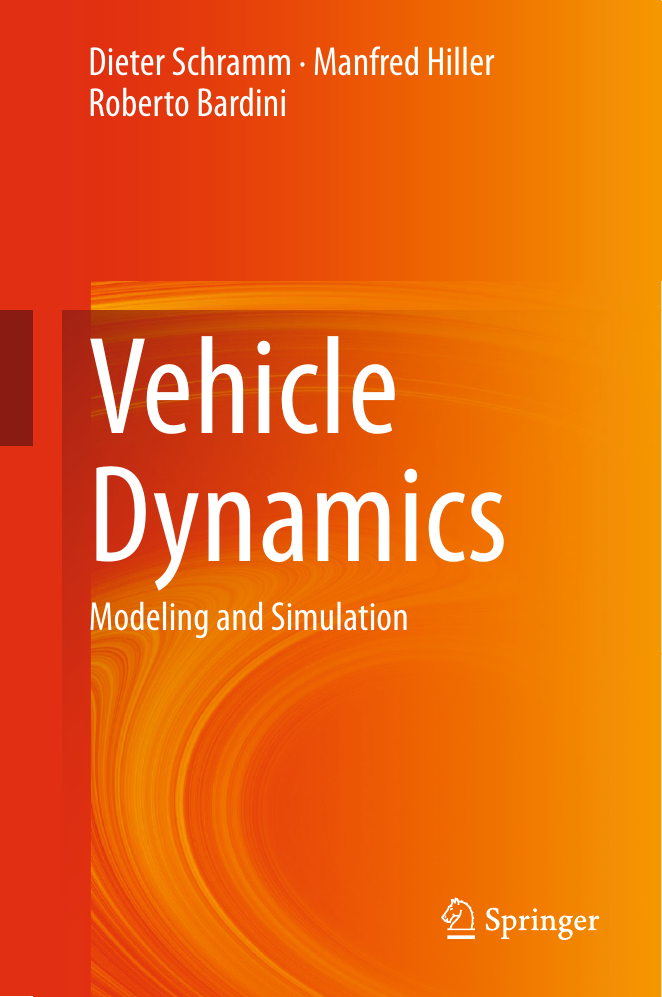
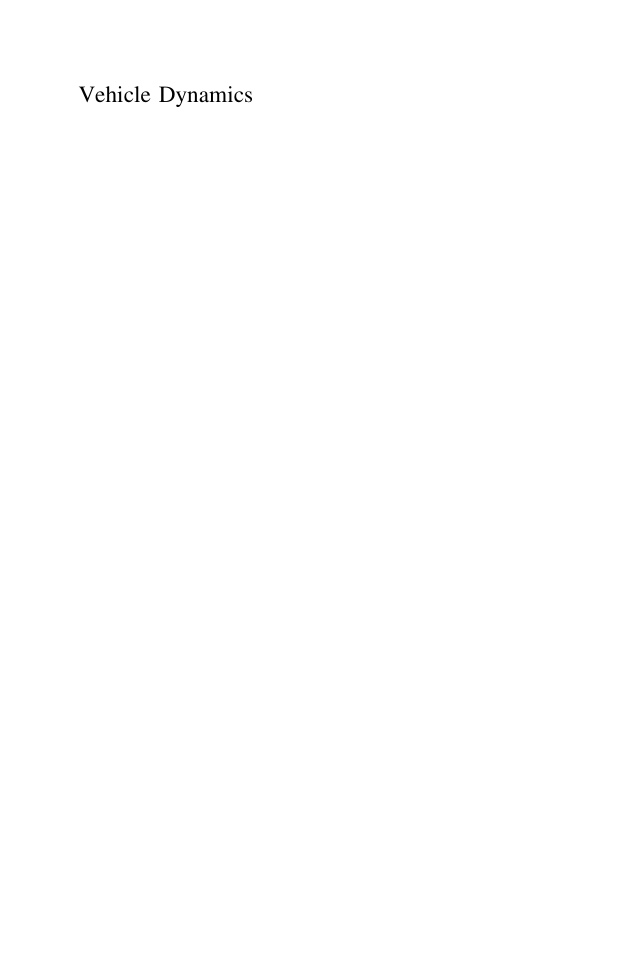
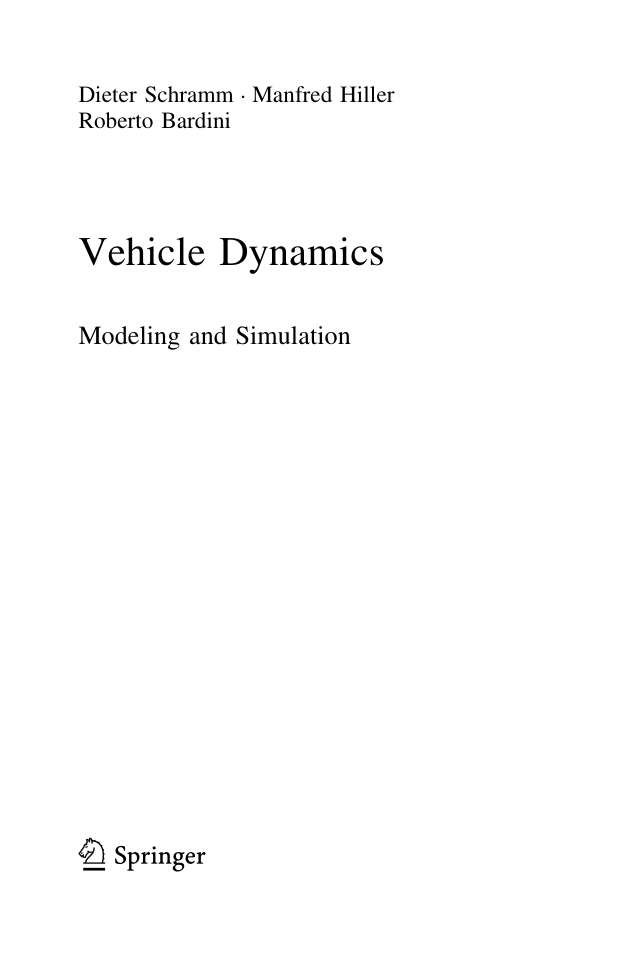
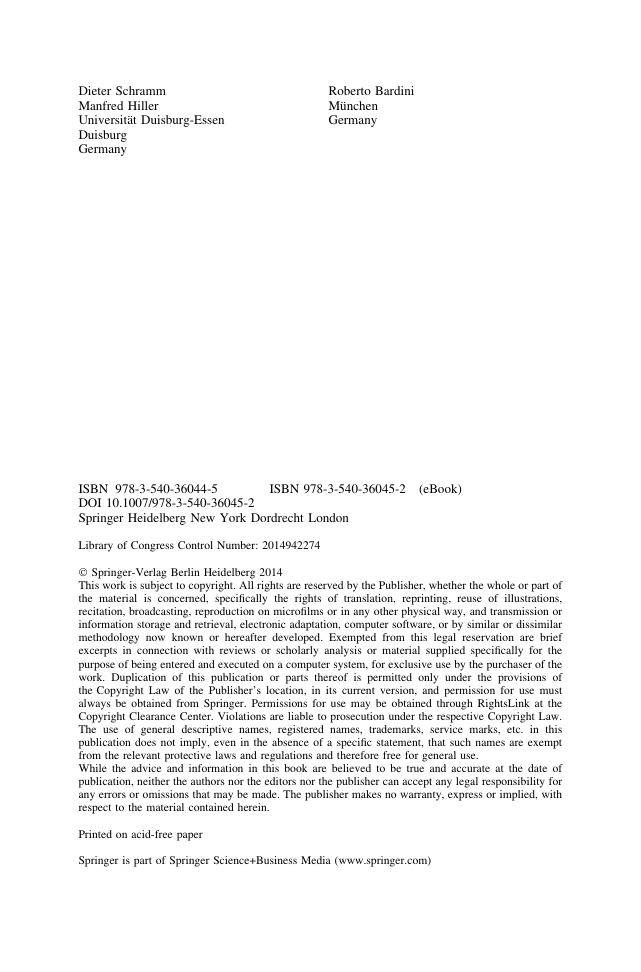
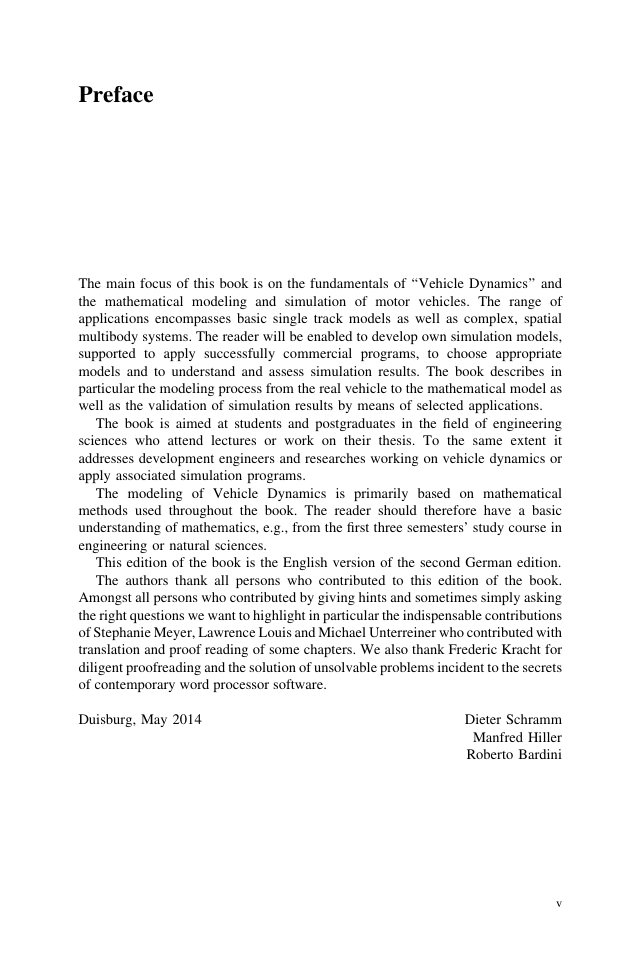
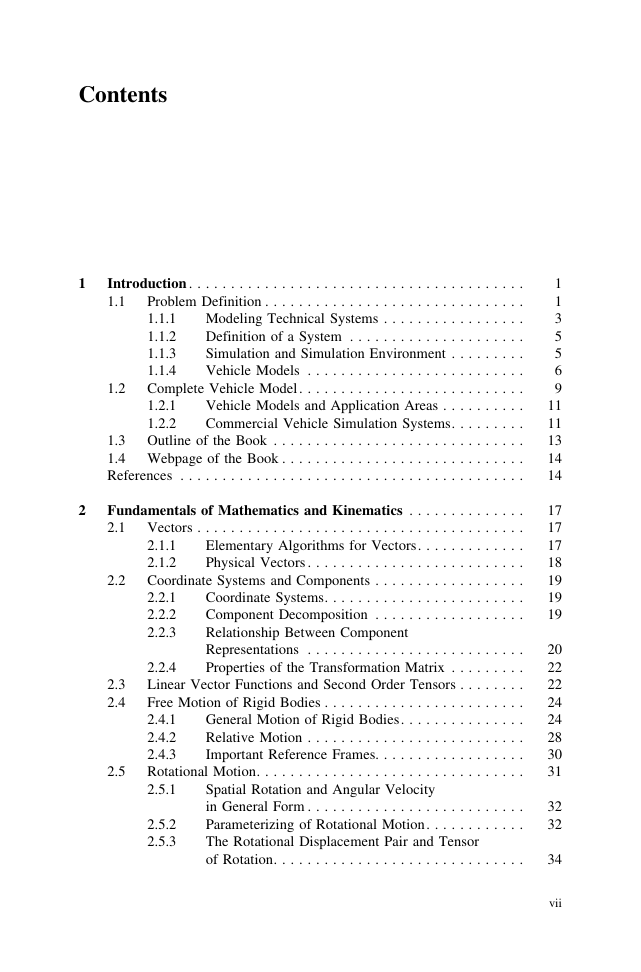
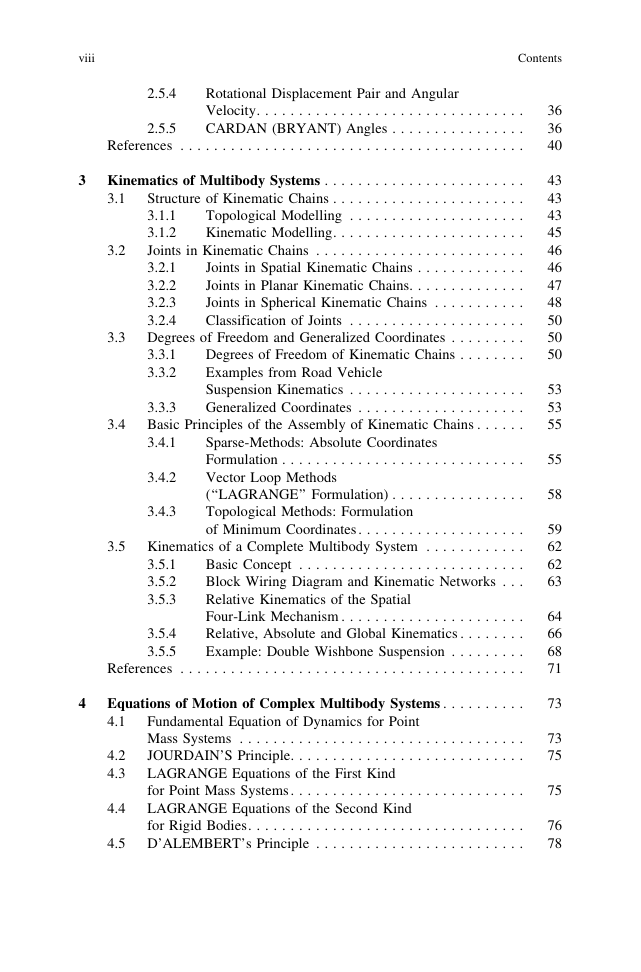









 2023年江西萍乡中考道德与法治真题及答案.doc
2023年江西萍乡中考道德与法治真题及答案.doc 2012年重庆南川中考生物真题及答案.doc
2012年重庆南川中考生物真题及答案.doc 2013年江西师范大学地理学综合及文艺理论基础考研真题.doc
2013年江西师范大学地理学综合及文艺理论基础考研真题.doc 2020年四川甘孜小升初语文真题及答案I卷.doc
2020年四川甘孜小升初语文真题及答案I卷.doc 2020年注册岩土工程师专业基础考试真题及答案.doc
2020年注册岩土工程师专业基础考试真题及答案.doc 2023-2024学年福建省厦门市九年级上学期数学月考试题及答案.doc
2023-2024学年福建省厦门市九年级上学期数学月考试题及答案.doc 2021-2022学年辽宁省沈阳市大东区九年级上学期语文期末试题及答案.doc
2021-2022学年辽宁省沈阳市大东区九年级上学期语文期末试题及答案.doc 2022-2023学年北京东城区初三第一学期物理期末试卷及答案.doc
2022-2023学年北京东城区初三第一学期物理期末试卷及答案.doc 2018上半年江西教师资格初中地理学科知识与教学能力真题及答案.doc
2018上半年江西教师资格初中地理学科知识与教学能力真题及答案.doc 2012年河北国家公务员申论考试真题及答案-省级.doc
2012年河北国家公务员申论考试真题及答案-省级.doc 2020-2021学年江苏省扬州市江都区邵樊片九年级上学期数学第一次质量检测试题及答案.doc
2020-2021学年江苏省扬州市江都区邵樊片九年级上学期数学第一次质量检测试题及答案.doc 2022下半年黑龙江教师资格证中学综合素质真题及答案.doc
2022下半年黑龙江教师资格证中学综合素质真题及答案.doc